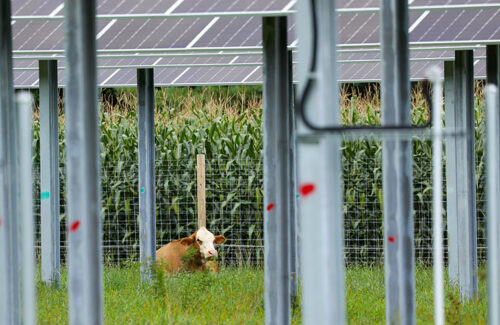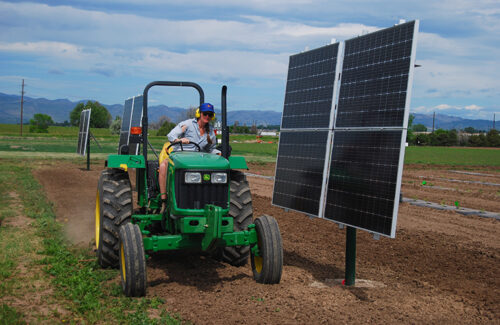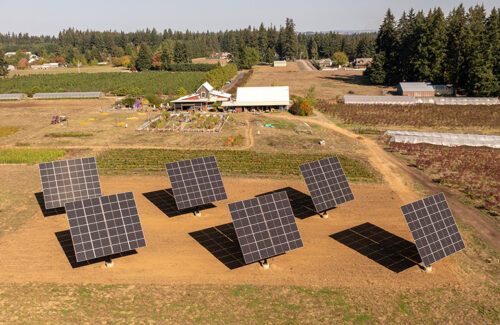
Solar brackets make agricultural photovoltaic projects possible
Making the solar bracket suitable for agricultural photovoltaic projects mainly means raising it to a higher column to provide sufficient clearance for anything that happens below the module. Increasing the height of the array will increase the impact of wind and other environmental conditions, requiring additional engineering to ensure that it can withstand the extra pressure. If the solar cell array still shares land with active agricultural equipment or livestock (especially cows), it must also be built to cope with possible collisions.

Based on our previous design decisions, we were born with the ability to resist or waterproof cows, "said Travis Jordan, CEO of MT Solar, a Montana solar bracket manufacturer. Even for large agricultural equipment, we can handle some slight rough shells. If the seeder is thrown off and hits a pillar, it won't cause any harm
MT Solar produces pole top mounted solar brackets for agricultural photovoltaic projects, inspired by Jordan's upbringing on off grid family farms. This pole type bracket uses a single ground installation point, which can minimize construction activities while still adapting to uneven terrain such as Montana hills and mountains. The module platform can be manually rotated to follow the trajectory of the sun throughout the year, and for agricultural photovoltaic purposes, it can be adjusted to free up space for placing agricultural equipment or planning shading.
Helge Biernath, CEO of solar contractor Sunstall and vertical shelving manufacturer Sunzaun, stated that shade is a valuable resource as many crops, such as root vegetables and leafy greens, only require a few hours of sunlight per day to grow; When working in the sunlight for a long time, agricultural workers attach great importance to shaded areas.
Sunzaon is a solar fence product with a smaller project footprint than other ground mounted brackets. Although its power generation capacity is not as good as a single axis solar tracker, it can be installed in narrower areas and still generate electricity.
You can actually gain some benefits from it, and your wooden fence won't bring you any return, "Biernath said. Yes, compared to that, capital expenditures will be high, but the other end will have money coming in, that's the difference
Polar Racking is a solar bracket manufacturer from Ontario, Canada, which designs three types of ground brackets for dual-use projects. Each model (vertical fence, fixed inclined east-west canopy, and single axis tracker) is designed to minimize the impact of construction on these agricultural sites by reducing the required number of piles and pre assembling components outside the site.

When we designed and proposed this tracker project, we saw its true value to the agricultural market, which is the ability to allow combine harvesters to enter underneath the equipment, "he said.
Let agricultural photovoltaics play a role
Planting solar panels and crops on the same piece of land simultaneously can increase the economic value of the land more than planting technology and crops separately. The power density of solar panels may not be as high as solar projects without crops, but the yield of crops and electricity will be more profitable than plots with only one of them.
The trade organization SolarPower Europe released the "Agricultural Solar Handbook" in 2024 as a resource for European farmers and solar developers, with the goal of making dual-use projects "benefit farmers, solar stakeholders, investors, and local communities".
American farmers and solar companies can refer to this manual, as agriculture in Europe and the United States face similar obstacles: land restrictions, income uncertainty, and water scarcity caused by climate change. According to the manual, agricultural photovoltaic projects have the potential to increase the yield of certain shade tolerant crops, enhance water retention capacity, maintain soil temperature, assist in soil carbon sequestration, and increase pollinator activity.
BlueWave, a solar developer in Boston, has a department dedicated to dual-use solar projects. Jesse Robertson DuBois is the Director of Sustainable Solar Development at BlueWave and a farmer in western Massachusetts.
The reason why I entered the solar energy industry is because I believe that farmers are very innovative people who know how to grow agricultural products or raise livestock in many different places, and these are not that difficult, "he said. Solar energy development is difficult. Agriculture is also difficult. You can find overlapping places - you don't need a magic wand - just find places and people with good overlap
Early agricultural photovoltaic projects are testing the rationality of solar bracket manufacturers, who are ready to meet the needs of agricultural communities. The power grid is electrified like agriculture, and on-site solar energy can provide assistance for both parties.

© Copyright: 2025 Xiamen Wintop New Energy Tech Co., Ltd.. All Rights Reserved.

IPv6 network supported